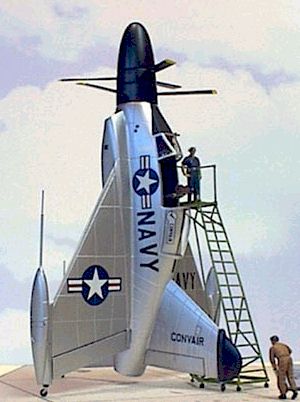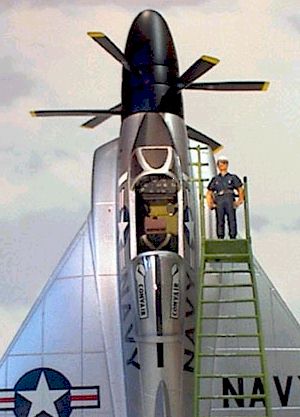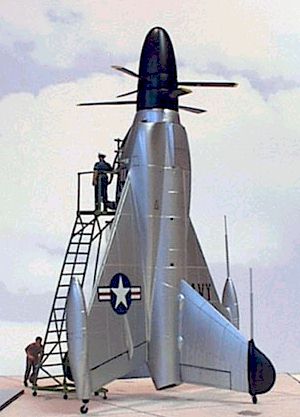Model
Subject: Convair XFY-1 "Pogo"
Kit
Used: Kovozŗvody Prostjov (KP), kit number 33
 Convairís
XFY-1 (Model 5) was a radical experimental single-seat fighter evolved
from a program to examine the feasibility of operating tail-sitting,
vertical-take-off-and-landing (VTOL) aircraft from small platforms on
ships. The single prototype built competed with Lockheedís XFV-1, but
both projects proved the concept was flawed due to pilot disorientation
with the planes in the vertical position. Convairís
XFY-1 (Model 5) was a radical experimental single-seat fighter evolved
from a program to examine the feasibility of operating tail-sitting,
vertical-take-off-and-landing (VTOL) aircraft from small platforms on
ships. The single prototype built competed with Lockheedís XFV-1, but
both projects proved the concept was flawed due to pilot disorientation
with the planes in the vertical position.
The aircraft featured wings of
modified delta planform and immense vertical surfaces (the ventral tail
being jettisonable to permit an emergency landing if necessary). The
XFY-1 rested on small castoring wheels at the tips of the wings and
vertical tailplanes. The pilotís ejection seat was mounted on gimbals,
which permitted it to tilt up 20 degrees when the aircraft assumed the
vertical attitude.
Power was provided by a 5,850
shp Allison YT40-A-6 (pending availability of the planned 6,955 shp
XT40-A-16) driving counter-rotating propellers. Proposed armament
comprised four 20 mm cannon in the wingtip pods and forty-eight 2.75 in
(70 mm) rockets in pods on under wing mounts outside the propeller arc,
but the prototype was never armed.
The XFY-1 effected its first
vertical take-off and landing on August 1, 1954 and its first transition
flight on November 2, 1954. Although flown for over 40 hours in tests,
severe piloting difficulties led to an abandonment of the program.
The surviving prototype of the
Convair XFY-1 "Pogo" is currently stored at Smithsonianís
NASM Garber storage facility in Silver Hill, Maryland. For years it
served as the gateguard for NAS Norfolk in Norfolk, Virginia.
It was here that I first saw the "Pogo" during the 1960's. |
Modifications
and Additions
|
 Interior Interior
The interior was built out-of-the-box with exception
of adding the seat belts and shoulder harnesses. The belts were cut from
sanded masking tape and the buckles cut from True Details American Belt
photoetched set.
Exterior
The exterior was likewise built straight
out-of-the-box, with exception of replacing the two long pitot tubes
with two sizes of hypo tubing as the kit pieces were bent and broken and
could not be properly repaired. I shortened the oleos on the castoring
wheels so that the model would sit lower, as the weight of the plane
would cause the oleos to rest almost flush with the wing and vertical
plane tips. |
This model was constructed under the KISS principle (keep it simple
stupid). With that in mind I decided to use Polly-Scale Metalline paints for
the metal finish. The vertical tailplane tips were first painted Polly-Scale
Night Black along with the propeller blades, spinner, and masked canopy
pieces.
 The black
was then masked on the vertical tips and anti-glare panel and the entire model
was airbrushed with Polly-Scale Bright Silver. Once dried, a few panels on the
vertical tails and fuselage undersurface were masked and sprayed Polly-S
Bright Aluminum. The difference is very subtle and can be seen in bright light
better than a lighted room. I removed all masking except for the anti-glare
panel and shot the model with a coat of Min-Wax Polycrylic Clear Gloss to
protect the fragile metal paint and prepare a surface for the decals. The prop
blades and spinner were also painted clear gloss at this time.
The black
was then masked on the vertical tips and anti-glare panel and the entire model
was airbrushed with Polly-Scale Bright Silver. Once dried, a few panels on the
vertical tails and fuselage undersurface were masked and sprayed Polly-S
Bright Aluminum. The difference is very subtle and can be seen in bright light
better than a lighted room. I removed all masking except for the anti-glare
panel and shot the model with a coat of Min-Wax Polycrylic Clear Gloss to
protect the fragile metal paint and prepare a surface for the decals. The prop
blades and spinner were also painted clear gloss at this time.
The propeller tips were first done with yellow trim film decal cut to
four-inch scale (.055 in). Since this was a little too translucent for my
liking, I carefully hand painted the yellow decal tips with Tamiya Flat Yellow
once the decals had thoroughly dried. The kit decals were used with exception
of the National Insignias, which were taken from a SuperScale sheet for modern
US National Insignia. Various vents were done with black decal trim film, with
the NACA duct being done with black and silver trim film.
Once all the decals had dried I gently washed the model and gave it a thin
wash coat of Polycrylic after masking the interior and anti-glare panel. The
propeller assemblies were also given a wash of Polycrylic. All recessed wing
and vertical tail controls were given a wash of India ink after the final
gloss had dried. The flat interior panels in the intakes were carefully hand
painted with Polly Scale Night Black, as were the exhausts, which also
received a dusting of light gray powdered pastel. The lower fuselage intake
was painted black prior to its attachment to the prepainted black outline on
the lower fuselage assembly.
Navigation lights were given a drop of kristal kleer and then painted clear
red and clear blue as required once the kristal kleer had completely set up.
After I built this model, I was able to find a copy of Steve Ginterís
monograph on the "Pogo". Since this book had pictures containing a
boarding ladder, I scratch-built one from styrene rod after first drawing
front and side profiles on index card stock. The two figures were from
Hasegawa and were installed to give some sense of scale to the model.
Home
| What's New |
Features |
Gallery |
Reviews |
Reference |
Forum |
Search